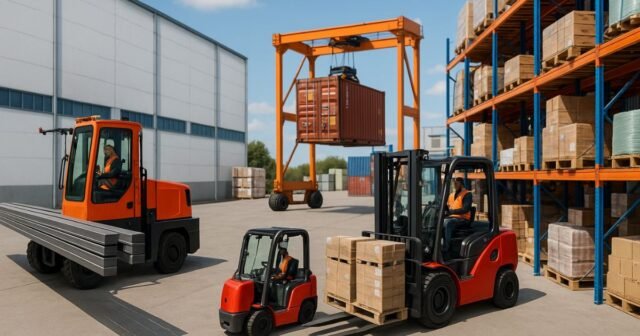Managing diverse, high-volume inventories requires much more than manpower and traditional pallet trucks. Companies handling long, heavy, or oddly shaped loads are turning to specialized equipment to optimize space, improve safety, and increase throughput. One crucial innovation for such challenges is the Side Loader Forklift, which allows warehouses and yards to maneuver lengthy materials with precision while maximizing storage density. But this is only part of the modern material-handling revolution. Let’s explore the role of innovative loading equipment in transforming operations for businesses with expansive and varied inventories.
The Evolving Demands of Modern Inventory Management
As consumer expectations shift toward faster deliveries and wider product variety, inventory complexity is increasing in many sectors. Manufacturers, distributors, and retailers now store a broader range of products—varying in size, weight, and shape—than ever before.
This variety introduces challenges:
- Space utilization: Traditional racking may not accommodate long or irregular items.
- Handling safety: Awkward, heavy, or delicate goods need precise movement to avoid damage.
- Labor efficiency: Manual processes are too slow or unsafe for many modern inventory profiles.
The response to these demands has been the development and adoption of specialized loading and transport equipment designed for efficiency, safety, and flexibility.
Space Optimization Through Specialized Design
Warehouses are expensive to build and maintain. Maximizing every cubic meter is essential for profitability. This goal has driven innovation in equipment design.
For example, a Side Loader Forklift allows operators to pick and transport long materials—like timber, piping, or steel beams—without needing large turning radii. By lifting loads from the side, these machines can travel narrow aisles that traditional forklifts cannot navigate while still carrying lengthy items. The result is denser racking systems, reduced travel distances, and more effective use of warehouse space.
Flexibility for Varied Inventory Profiles
Beyond long loads, businesses often manage inventories with vastly different handling needs: pallets, crates, pipes, sheets, or even containers. Rigid, single-purpose machines can’t provide the flexibility required in such environments.
This is where innovations like the Multi-Directional Forklift prove essential. Unlike conventional forklifts, these models can move in all directions, including sideways, diagonally, and rotationally. They excel at maneuvering in tight spaces and around obstacles, reducing the need for costly aisle widening or facility redesigns.
For companies with unpredictable or constantly changing inventory types, such flexibility isn’t a luxury—it’s critical to avoid bottlenecks and maintain high throughput.
Handling Oversized and Heavy Loads Safely
Safety is always a primary concern in material handling, especially with oversized or heavy items. Accidents can damage valuable inventory, harm employees, and disrupt operations.
Specialized loading equipment reduces these risks by:
- Providing stable load control with purpose-built forks or clamps.
- Improving operator visibility with elevated cabs or camera systems.
- Allowing precise, smooth movements to avoid load shift or tipping.
Operators trained on modern equipment handle even complex or fragile items with greater confidence and safety. This not only protects inventory but also contributes to better worker morale and lower injury rates.
Reducing Manual Labor and Operational Costs
Labor costs remain one of the biggest expenses in logistics and warehousing. While skilled employees are indispensable, the physical strain and inefficiency of purely manual loading and unloading processes are unsustainable for many businesses.
Innovative equipment streamlines these processes:
- Faster loading and unloading cycles mean fewer workers can handle higher volumes.
- Automation-ready designs support integration with conveyors, AGVs (Automated Guided Vehicles), or warehouse management systems.
- Reduced wear and tear on employees decreases absenteeism and turnover.
The initial investment in advanced forklifts, carriers, or loaders is often quickly recouped through lower labor costs and higher productivity.
Adapting to Outdoor and Port Environments
Not all inventory is stored neatly in indoor racking. Ports, rail yards, and large outdoor facilities have their own challenges, with exposure to weather, large containers, and variable terrain.
For these settings, Straddle Carriers offer a specialized solution. They can lift and transport oversized, heavy containers without relying on cranes or multiple forklifts. Their design allows them to “straddle” loads, lift them securely, and move them across the yard efficiently. This is especially valuable for intermodal transport hubs where speed and precision are critical to keeping supply chains moving.
Sustainability and Future-Proofing Operations
Modern material-handling equipment is also responding to environmental pressures. Electrification, hybrid drivetrains, and improved fuel efficiency help reduce the carbon footprint of warehouse and yard operations. Many manufacturers now offer electric versions of traditionally diesel-powered loaders and forklifts, reducing emissions without sacrificing power.
Additionally, advanced telematics and fleet management tools help companies monitor usage, optimize routes, and plan maintenance proactively. This extends equipment life, reduces downtime, and improves ROI.
Making the Right Investment
For companies with expansive and varied inventories, choosing the right loading equipment isn’t just about capacity ratings or upfront cost. It’s about:
- Understanding the specific load profiles you handle.
- Analyzing facility constraints, such as aisle widths or ceiling heights.
- Planning for growth or changes in product lines.
- Balancing short-term cost with long-term efficiency gains.
Partnering with equipment suppliers who understand these needs and can customize solutions is often the smartest approach.
Conclusion
Expansive, varied inventories are here to stay. Businesses that invest in the right innovative loading equipment will be best positioned to handle these challenges while maintaining safety, reducing costs, and boosting productivity. From the maneuverable Side Loader Forklift for long loads, to the highly adaptable Multi-Directional Forklift for complex warehouse layouts, to the heavy-duty Straddle Carriers in ports and yards, these specialized machines are essential tools in the modern supply chain. Embracing them is not just about keeping up—it’s about staying ahead.







